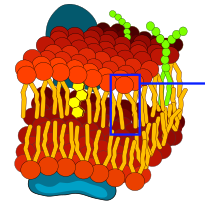Chapter 7-3 Cell Boundaries

1. Name two functions of the cell membrane: ________________________________________
2. The cell membrane contains ____________________molecules that are embedded
in the lipid bilayer.
3. Why do scientists call the membrane a "mosaic"? ________________________
4. What three types of organisms have cell walls? ____________________
5. What is the main function of the cell wall? ________________________
6. What are plant cell walls composed of? ___________________
7. One of the most important functions of the cell membrane is to __________________
the movement of dissolved ________________________ from the liquid on one side
of the membrane to the liquid on the other.
8. A solution is a ________________________ of two or more substances.
9. Define diffusion: ________________________________________
10. When the particles are the same throughout, the system has reached ________________
11. Diffusion depends on ____________________ particle movements, therefore
it [ does | does not ] (circle) require energy.
OSMOSIS
12. If a substance is able to diffuse across a membrane, the membrane is said
to be _______________
13. Define osmosis: ___________________________________________________
14. Isotonic means _____________________________
Hypertonic means ___________________________
Hypotonic means ____________________________
15. Because cells are hypertonic in relation to fresh water, ___________________________
produces a net movement of water into the cell.
16. In plant and bacteria cells, what keeps them from bursting due to osmotic
pressure? ___________
FACILITATED DIFFUSION
17. Cell membranes have _________________________ that make it easy for certain
molecules to cross the membrane.
18. When proteins help molecules move across the membrane, it is called _________________________
ACTIVE TRANSPORT
19. Active transport moves molecules [ with | against ] the concentration gradient.
20. Active transport requires _____________________________
21. Changes in protein shape seem to play an important role in the ______________
process.
22. Define endocytosis: _______________________________________________________
23. What are the two types of endocytosis? ________________________________________
24. How does an amoeba gets it food? ___________________________________
25. Cells release large amounts of material in a process called _________________________
TEST YOURSELF
1. Which of the following is an example of active transport? a. facilitated diffusion b. osmosis c. endocytosis
2. Which process always involves the movement of materials from inside the cell to outside the cell?
a. osmosis b. exocytosis c. phagocytosis d. pinocytosis
3. Cell membranes are constructed mainly from: a. lipid bilayers b. carbohydrate gates c. protein pumps
4. A substance that moves across a cell membrane without using the cell's energy tends to move:
a. away from the area of equilibrium
b. away from the area where it is less concentrated
c. away from the area where it is more concentrated
d. toward the middle of the cell
5. The movement of water across a selectively permeable membrane is called: a. exocytosis b. endocytosis c. osmosis

